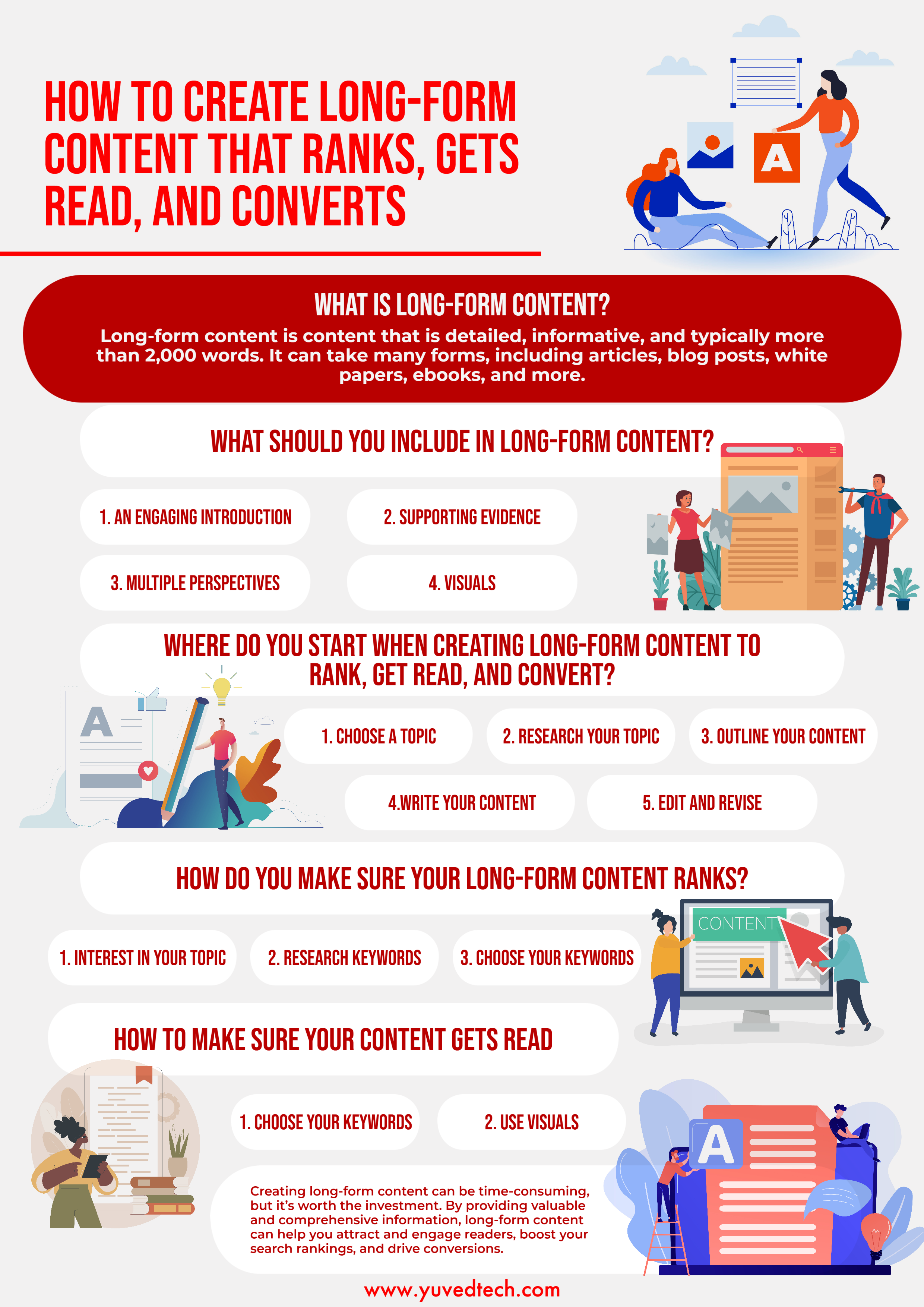Long-form content is a type of content that is in-depth, detailed, and typically more than 2,000 words. It can take the form of articles, blog posts, white papers, ebooks, and more. When done well, long-form content can be an effective way to attract and engage readers, boost your search rankings, and drive conversions. But how do you create long-form content that achieves all of these goals? Here’s what you need to know:

What is long-form content?
Long-form content is content that is detailed, informative, and typically more than 2,000 words. It can take many forms, including articles, blog posts, white papers, ebooks, and more. The goal of long-form content is to provide readers with a comprehensive and in-depth understanding of a specific topic or issue.
What should you include in long-form content?
When creating long-form content, it’s important to include a range of information and perspectives to make your content as comprehensive and valuable as possible. Here are a few key elements to include in your long-form content:
- An engaging introduction: The introduction of your long-form content is crucial for grabbing readers’ attention and setting the stage for the rest of your piece. Start with a strong headline and an engaging opening that draws readers in and sets the tone for your content.
- Supporting evidence: In order to make your content credible and persuasive, it’s important to include supporting evidence such as research, statistics, and case studies. This helps to back up your claims and make your content more convincing.
- Multiple perspectives: To make your content as comprehensive as possible, consider including multiple perspectives on your topic. This could include expert opinions, personal experiences, and different viewpoints.
- Visuals: Long-form content can be dense and difficult to read, so it’s important to include visuals such as images, videos, and infographics to break up the text and make your content more visually appealing.
Where do you start when creating long-form content to rank, get read, and convert?
Before you start writing your long-form content, it’s important to do some research and planning to ensure your content is as effective as possible. Here are a few steps to follow:
- Choose a topic: The first step in creating long-form content is choosing a topic that is relevant and interesting to your target audience. Consider what issues or questions your audience is most interested in and how your content can provide valuable insights or solutions.
- Research your topic: Once you have a topic in mind, do some research to gather information and ideas for your content. This could include reading articles, conducting interviews, and collecting data and statistics.
- Outline your content: Before you start writing, create an outline of your content to organize your ideas and ensure you cover all of the key points you want to make. This will also help you see how your content flows and make any necessary changes before you start writing.
- Write your content: With your outline in hand, start writing your content. Be sure to include an engaging introduction, supporting evidence, multiple perspectives, and visuals as you go.
- Edit and revise: Once you’ve finished writing, take the time to edit and revise your content to ensure it’s clear, concise, and well-written. Consider having someone else read your content and provide feedback as well.
How do you make sure your long-form content ranks?
In order for your long-form content to rank well in search results, it’s important to optimize it for search engines. Here are a few key strategies to consider:
- Interest in your topic: One of the most important factors for ranking well in search results is having a topic that people are interested in. To determine the level of interest in your topic, consider using tools like Google Trends or keyword research tools to see how often people are searching for your topic.
- Research keywords: Once you have a topic in mind, do some keyword research to identify the specific terms and phrases that people are using to search for your topic. This will help you understand what language to use in your content and how to optimize it for search engines.
- Choose your keywords: Once you have a list of keywords, choose a few that you will focus on in your content. These should be relevant to your topic and reflect the language that people are using to search for your topic. Be sure to include these keywords in your headline, subheadings, and throughout your content.
How to make sure your content gets read
While ranking well in search results is important, it’s also crucial to make sure your content is engaging and easy to read. Here are a few strategies to consider:
- Optimize your content piece: To make your content more readable, consider using formatting techniques such as subheadings, bullet points, and short paragraphs to break up the text and make it easier to scan. You should also use headlines and subheadings to clearly convey the main points of your content.
- Use visuals: As mentioned earlier, visuals such as images, videos, and infographics can help make your content more engaging and visually appealing. Consider incorporating these elements into your content to make it more interesting and engaging.
Long-form content is worth the investment
Creating long-form content can be time-consuming, but it’s worth the investment. By providing valuable and comprehensive information, long-form content can help you attract and engage readers, boost your search rankings, and drive conversions.
If you’re looking to create long-form content but don’t have the time or expertise to do it yourself, consider working with a digital marketing agency like Yuved Technology. With their expertise and experience, Yuved Technology can help you create long-form content that adds value to readers’ lives and helps your business achieve exponential growth.

